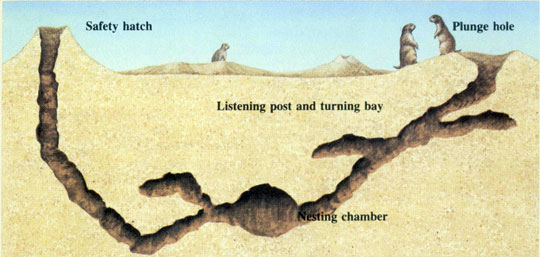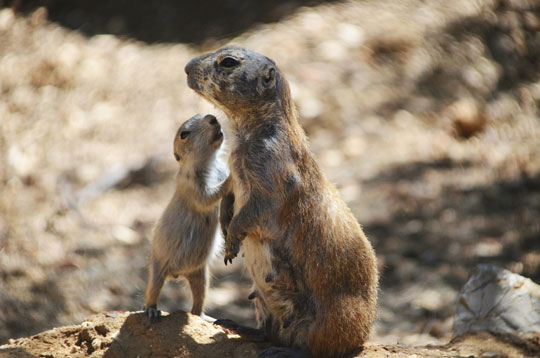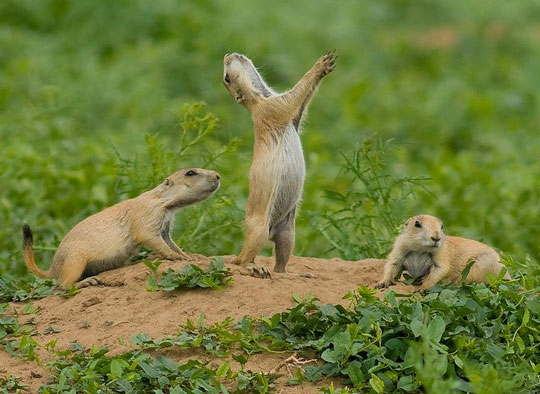|
Like many of my novels, the upcoming Hostile Emergence features a number of strange creatures, some friendly, some not so friendly. Also, sometimes you think they may be friendly, but then they surprise you. In Hostile Emergence, Skyra, Lincoln, and their team encounter a vast colony of prairie dogs (called a prairie dog town). In honor of the new book's release, today's Awesome Animal is the prairie dog! What the heck is a Prairie Dog? First of all, prairie dogs are rodents, in a group referred to as ground squirrels. The five species of prairie dogs are all found in North America, especially in the Great Plains. The name prairie dog comes from the fact that they tend to live on prairies, and their alarm call often sounds like the barking of a dog (although a very small, squeaky dog). Prairie dogs average about 15 inches (38 cm) long, with an average weight of about 2 pounds (.9 kg). Most people would describe prairie dogs as "cute," except maybe landowners who do not like all the burrows and mounds. Amazing Facts about Prairie Dogs Prairie dogs are what we call a keystone species. This means they are a type of animal in a particular ecosystem that many other animals rely on. If a keystone species is removed from an ecosystem, this will drastically change the balance of life there. Scientists estimate that about 150 other species depend on prairie dogs for their survival. For starters, many predators feed on prairie dogs. A few examples: hawks, badgers, coyotes, bobcats, weasels, foxes, eagles, and black-footed ferrets. In fact, black-footed ferrets feed almost entirely on prairie dogs, and these ferrets are almost extinct due the extreme loss of prairie dog colonies resulting from habitat destruction (the prairie dog's historical range has shrunk by more than 95%). So many animals feed on prairie dogs that Kristy Bly of the World Wildlife Foundation called prairie dogs the "Chicken McNuggets of the grasslands." Getting munched on is not the only reason prairie dogs are a keystone species. They live in vast colonies, and their activities improve the quality of the soil (their tunnels aerate it and their droppings fertilize it). Check out this video on prairie dog towns. Prairie dog towns can be huge. Many of the largest prairie dog colonies are now a thing of the past due to urban and suburban development. However, prairie dogs were once considered the most abundant mammals in North America. Some prairie dog towns are relatively small, perhaps only a few acres. In Kansas, though, there is one that still exists today that is over 100 miles (160 km) long! Prairie dogs are very social animals. They live in family groups called coteries. Well, actually, the families are called coteries in two species of prairie dogs (black-tailed and Mexican prairie dogs), but family groups are called clans in the other three species (white-tailed, Gunnison’s, and Utah prairie dogs). If you're wondering why the different names for family groups, coteries tend to be more tightly-knit groups than clans. There are certain behaviors (kissing and grooming) prairie dogs do only with members of their own coterie and not with members of other coteries. A coterie (or clan) is the group that lives within a single burrow. Multiple coteries are grouped together to make a neighborhood, and multiple neighborhoods make up a prairie dog town (a colony). Each coterie will have a few breeding males, a larger number of breeding females, and however many young they are raising at any given time. Females stay within their coterie for their entire lives, while males leave the groups when they become mature to find another group to breed in (this avoids excessive inbreeding). Below is a typical burrow for a prairie dog coterie. Remember we talked about 150 other animals that rely on prairie dogs? Many animals make prairie dog burrows their homes. Examples include rabbits, rattlesnakes, salamanders, spadefoot toads, camel spiders, countless insects, and other animals that can’t dig burrows on their own. Many of these occupy the burrows even when prairie dogs live there, and others, such as the burrowing owl, live in abandoned burrows. If you blink, you might miss the prairie dog mating season. We tend to think that prairie dogs are prolific breeders. Not really true. Female prairie dogs only mate one time per year, in early winter. When it's time, they go into estrus for only one hour. That's not a typo—one hour! If mating is successful, they will have a litter of three to eight pups. On average, only half of those pups will survive their first year. Here's an interesting tidbit: Once a male has mated with a female, he will not mate with her again during her brief estrus. However, he will prevent other males from mating with her by inserting what's called a mating plug (also called a copulation plug). Yep, this is a real thing. Many animals have these. It's a gelatinous secretion the male deposits in the female, and it solidifies to prevent other males from having access. Weird, huh? Once the young are born, the adult females care for the young, while the males defend the burrow (they may look cute, but prairie dogs can be vicious fighters). We definitely need to talk about prairie dog communication. Prairie dogs do a lot of yipping. Yip-yip-yip-yip. To us mere humans, all these yips may sound similar, but prairie dogs have an astounding array of communication signals, especially related to predator warnings (everything wants to eat prairie dogs, remember?). Scientists have found that prairie dogs can not only signal that a predator is approaching, they can also put together strings of sounds that communicate the predator species, size, color, speed, and direction. I know... this seems hard to believe, but extensive behavior studies have shown it to be true. For example, prairie dogs can alert each other that there’s not just a human approaching, but a tall human wearing the color blue. Amazing! This should give you an idea of how complex these calls can be: When a prairie dog signals that a hawk is approaching, all the prairie dogs that are directly in the path of the approaching hawk will dive into their holes, while all those outside of the hawk's path will stand on their hind legs and watch. Prairie dogs also have specific calls when they see an animal they know is not a predator. Prairie dogs even have a call to signal that a predator is gone. The call is a jump-yip, in which the caller arches its back so suddenly that it jumps off the ground, then this is followed by a shrill yip. See below. Finally, you may have seen photos of prairie dogs kissing. This seemingly romantic behavior is actually how they confirm that another prairie dog is part of their family group. Regardless, you have to admit there is something endearing about it, right? So, the Prairie Dog deserves a place in the S.A.H.O.F. (Staggering Animal Hall of Fame). FUN FACT: The term staggering was first used in the mid 1400s. As I'm sure you can guess, it came from the word stagger, which means to "walk unsteadily." Stagger actually comes from stakeren, a Scandinavian word meaning "to push, shove, cause to reel." And that word may have had an original literal meaning of "to hit with a stick." Anyway, in the mid 1400s, people came up with staggering, an adjective to describe something so amazing or overwhelming that it makes you stagger. It still means pretty much the same thing today. So, staggering is another way to say awesome! Photo Credits:
Alligator and manatee - Patrick M. Rose/SAVE THE MANATEE CLUB via Wired Sloth - UW-Madison/Zach Peery via Phys.org Bat with baby - San Diego Zoo Prairie dog #1 - Deposit Photos stock images Prairie Dog Town - Texas Coop Power Prairie dog burrow - Devil's Tower Handbook Prairie dog with young - Deposit Photos stock images Prairie dog jump-yip - Wikimedia Commons Prairie dogs kissing - KXCI
0 Comments
I know... many people hate spiders. I get it. However, jumping spiders are different. They're furry and, well, their faces are just darn cute! You know what jumping spiders are, right? They are those compact little fuzzballs with eight legs that crawl around with short bursts of speed. If you try to touch them, they disappear. Well, they don't actually disappear—they jump. They jump so quickly that often you hardly see them do it, and they seem to disappear. And when you look really closely... those eyes! What the heck is a Jumping Spider? Jumping spiders make up the family Salticidae. Astoundingly, there are over 6,000 species that we know of so far! Yep, six thousand—it's the largest family of spiders. I'd love to include a photo of each species, but I don't think that's going to happen. Jumping spiders, which are typically small, have highly-developed eyes, with better vision than almost all other arthropods (arthropods also include insects, crustaceans, scorpions, centipedes, and many other creatures with exoskeletons). Amazing Facts about Jumping Spiders Let's begin with these spiders' jumping ability. As I'm sure you can guess, this ability is important to the way they hunt their prey. A jumping spider spots a prey animal using its amazing eyes. Then it carefully approaches the creature, trying to decide if the prey is suitable as a meal. Before jumping on its prey, the spider attaches a filament of silk (called a dragline) to the surface it is standing on. Then the spider launches itself through the air to attack. Take a look at the legs of the spiders in the photos above—tiny little legs! Those aren't big, powerful legs like a grasshopper's hind legs. So, how does a jumping spider jump with such force? It's all about hydraulics. Jumping spiders have jointed legs, like we do, but their legs each have seven segments. Like humans, spiders have flexor and extensor muscles. Extensor muscles are the ones that can be contracted powerfully to extend a leg, allowing a creature like a grasshopper or a human to jump. The weird thing is, jumping spiders do not have extensor muscles at two of the seven joints of their legs—and these are the joints that give them their jumping power! So then how do they jump? Like I said, hydraulics. The jumping spider has the ability to force hemolymph (the spider's version of blood) out of its cephalothorax and into its legs. This sudden injection of blood into the legs causes the legs to straighten with great force, sending the spider flying through the air. They can jump up to 50 times the length of their own body. Pretty cool, huh? If the spider misses its prey, or if the prey struggles and shakes the jumping spider off, the spider can just climb back up its safety dragline to get back to where it started. Check out this video about how jumping spiders jump. We really need to talk about the jumping spider's eyes, which are perhaps their most impressive feature. Jumping spiders have four pairs of eyes, and each pair serves a different purpose. There are two pairs of small eyes on the sides of the head, and two pairs of larger eyes mounted in the front of the head (see below). On the sides of the head there is the pair of posterior medial eyes and a pair of posterior lateral eyes. The posterior medial pair don't really see distinct images—they just detect the level of available light. The posterior lateral pair are good at detecting motion to the sides and behind the spider, giving the spider almost 360° vision. It's the two pairs of front eyes that are most amazing, though. These are called the anterior lateral eyes (the two smaller ones), and the anterior medial eyes (the two large ones). The anterior lateral pair have good visual acuity, and they are spaced widely apart, helping the spider with depth perception. The anterior medial pair (the biggest eyes) have extremely good vision. The retinas of these eyes can actually swivel around on their own, so that the spider can look around without moving its head. These eyes are acute, and some jumping spiders have an astounding ability to see color details, even into the UV range. This gets a little complex, but I want to explain how these two big eyes help the spider estimate distance (which is important to a creature who likes to jump on its prey). These two eyes are too close together for depth perception, so jumping spiders have evolved a unique alternative called image defocus. It's all done with green light. Here's how it works: Incoming green light is focused on the deepest layer of the retina. So, green light passing through the surface layers of the retina is out of focus, or fuzzy. The spider is capable of measuring the amount of defocus (fuzziness) between the deep layer and the surface layers, and it uses that information to determine the distance of the object in front of its face. Wow! Okay we need to discuss one other amazing thing about jumping spiders—their elaborate mating rituals. The males have evolved spectacular dances and displays to try to impress a potential mate. We can divide these displays into two categories, those without color and those with color. You see, many jumping spiders are not capable of seeing a wide range of colors. Those species have elaborate dances, but it is mostly shuffling around, waving their legs in the air, and shaking their booty. Impressive, but... There are also some species of jumping spiders that can see colors. The males of those species take advantage of this, and they add colorful enhancements to their booty-shaking dances. The male peacock spider, for example, has a brightly-colored abdomen flap, which it flips up and down like a decorative flag. I could describe these mating dances all day long, but you wouldn't really get a feel for what they are like unless you see them in action. This video is a great way to witness the displays for yourself. Now, don't you agree there's more to jumping spiders than meets the eye? The next time you see one skittering around in your house, instead of smashing it, take a closer look. So, the Jumping Spider deserves a place in the G.E.A.H.O.F. (Gilt-Edged Animal Hall of Fame). FUN FACT: The term gilt-edged was first used in about 1810. Originally, the adjective gilt was another way to say gilded. Gild is a verb, meaning "to cover with a thin layer of gold." So, something that has been gilded is covered with a layer of gold, such as the pages of an old book having gilded edges. Gilt-edged originally meant the same thing as gilded. Eventually, people began using gilt-edged in business to refer to the safest kinds of investments (such as government bonds). And then, as often happens, people began to us the term to refer to anything of the highest quality. So, gilt-edged is another way to say awesome! Photo Credits:
Jumping Spider #1 - DepositPhotos Stock Images Two jumping spiders on finger - Jurgen Otto/University of Cincinnati Magazine Jumping spider leaping - Scott Linstead Jumping spider eyes - DepositPhotos Stock Images Jumping spider on green background - DepositPhotos Stock Images Peacock jumping spider - Jurgen Otto/University of Cincinnati Magazine |
Stan's Cogitations
Everyone needs a creative outlet. That's why I write. Archives
July 2024
|













 RSS Feed
RSS Feed